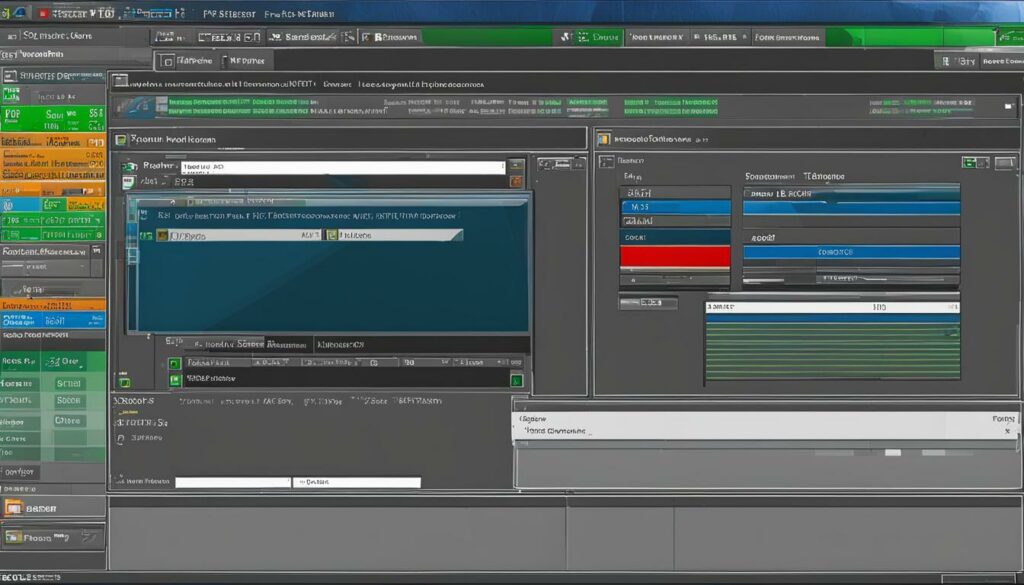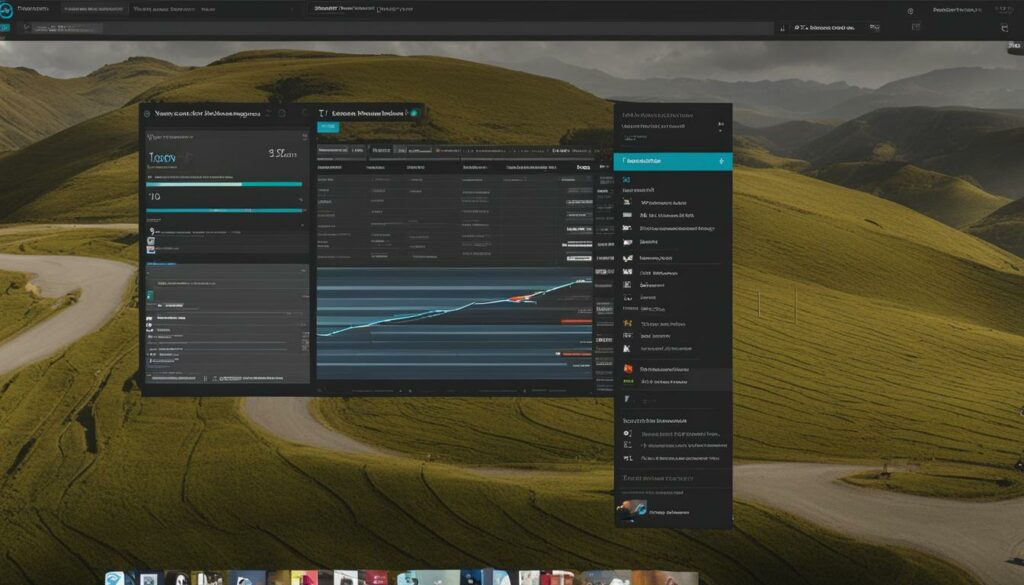Welcome to “Smooth Transitions: A Comprehensive Guide to WordPress Site Migration.” If you’re considering migrating your WordPress site, you’ve come to the right place. This guide will walk you through every step of the process, ensuring a smooth and hassle-free transition to your new host or domain.
Whether you’re moving your site to a new hosting provider, transferring it to a different server, or simply updating your domain, this guide will provide you with the essential knowledge and tools you need to make the migration process seamless.
At BoostedHost, we recommend our WordPress Hosting service for optimal performance throughout the migration process. With our reliable hosting, you can trust that your site will remain secure and accessible during the transfer. Sign up now through this link: www.boostedhost.com/wordpress-hosting.
Key Takeaways:
- WordPress site migration can be complex, but with the right plan and tools, it can be made smooth and hassle-free.
- Consider manual or automated migration based on the size and complexity of your website.
- Back up your website before starting the migration process.
- Prepare the destination server by installing WordPress and setting up the necessary database and user accounts.
- Export your database from the current website and import it into the new server.
Now that you’re ready to embark on your WordPress site migration journey, let’s dive into the details and ensure a successful transition.
Should my WordPress Site be Migrated Automatically or Manually?
When it comes to migrating a WordPress site, you have two options: manual migration or automated tools/services. The decision ultimately depends on the size and complexity of your website, as well as your technical expertise.
Manual migration involves hands-on work and requires knowledge of FTP, databases, and back-end file editing. If you are comfortable with these technical aspects, manual migration can provide more control and customization options.
On the other hand, automated migration tools and services offer a more straightforward approach for those who prefer a simpler process. Many web hosting providers offer free migration services, allowing you to effortlessly transfer your WordPress site to their platform.
If you decide to go the automated route, make sure to choose a reputable WordPress migration tool or plugin. These tools streamline the migration process and minimize the chances of errors or data loss.
However, for those who prefer a more hands-on approach, manual migration can be a viable option. Just keep in mind that it may require more time and effort, especially if you have a large or complex website.
Additionally, if you’re not comfortable with handling the technical aspects of migration, there are WordPress development services available to assist you. These professionals have extensive experience in WordPress site migration and can ensure a seamless transition.
In the end, the choice between manual and automated migration depends on your comfort level, technical expertise, and the specific needs of your WordPress site. Whether you choose to migrate manually or use automated tools, it’s crucial to plan and prepare adequately to minimize any potential disruptions during the migration process.
| Migration Method | Pros | Cons |
|---|---|---|
| Manual Migration |
|
|
| Automated Migration |
|
|
How do you Perform a Manual Migration of your WordPress Website?
Manual migration of a WordPress website involves migrating all the site files and databases manually. This requires access to the core directories and files of your website. Here is a step-by-step guide to help you navigate through the process:
1. Choose a New Hosting Provider
Before starting the migration process, select a new hosting provider that meets your requirements. We recommend WordPress Hosting from BoostedHost for optimal performance. Sign up now through this link: www.boostedhost.com/wordpress-hosting.
2. Take a Backup of Your Site’s Files and Database
To ensure the safety of your website data, take a backup of your WordPress site’s files and database. This includes all the themes, plugins, media files, and other important elements of your site. Use a reliable backup plugin or manually copy the files to a secure location on your computer.
3. Export the WordPress Database
Access your WordPress dashboard and navigate to the “Tools” menu. From there, select the “Export” option. Choose the “All content” option to export all your website’s posts, pages, comments, and other data into an XML file. This file will later be used to import the data into the new database on the destination server.
4. Generate a New SQL Database
On the new hosting provider’s control panel, create a new SQL database and user account. Make note of the database name, username, and password, as you will need them in the next steps.
5. Import the Contents from the Previous Database
Using the control panel or a database management tool provided by your new hosting provider, import the XML file containing the exported data into the new SQL database. This will restore your website’s content, including posts, pages, comments, and more.
6. Update the wp-config.php File
Access the core files of your WordPress installation using an FTP client such as FileZilla. Locate the wp-config.php file and open it for editing. Update the database connection details to reflect the new database name, username, and password. Save the changes and close the file.
7. Change the DNS Settings
If you’re changing domains, you need to update the DNS settings to point the domain to the new server. This can be done through your domain registrar’s control panel. Be aware that DNS changes may take some time to propagate across the internet, so be patient as you wait for the migration to complete.

Performing a manual migration of your WordPress website can be a complex process, but by following these steps, you can ensure a successful transfer to a new hosting provider. Remember to back up your files and database, export and import the WordPress database, update the wp-config.php file, and change the DNS settings. In case you prefer an easier solution, consider using a professional WordPress migration service or a reputable migration plugin.
Backup Your Website
Before starting the migration process, it’s crucial to create a complete backup of your WordPress website. This includes backing up files, databases, themes, plugins, and media files. Backup plugins like UpdraftPlus or VaultPress can be used to simplify the backup process and ensure that all data is safely stored in case anything goes wrong during the migration.
Why is website backup important?
Backing up your website ensures that you have a copy of all your website data, including files, databases, and important configurations. In case of any unforeseen issues during the migration process, having a backup ensures that you can easily restore your website to its previous state.
With a reliable backup solution like UpdraftPlus or VaultPress, you can schedule regular backups of your website, ensuring that your data is always up to date. These backup plugins offer features like automated backups, easy restoration options, and even remote storage options to keep your backups safe.
Choosing a Backup Plugin
When selecting a backup plugin for your WordPress site, it’s important to consider factors such as ease of use, reliability, and compatibility with your hosting environment. UpdraftPlus and VaultPress are two popular backup plugins that offer comprehensive features and seamless integration with WordPress.
UpdraftPlus is a widely-used backup plugin that allows you to easily back up your files, databases, plugins, themes, and more. With its intuitive interface and flexible backup scheduling options, you can set up automatic backups according to your preferred frequency.
VaultPress, on the other hand, is a backup and security scanning plugin specifically designed for WordPress sites. It offers real-time backups, spam protection, and malware scanning to keep your website secure. With VaultPress, you can easily restore your website with just a few clicks.
The Importance of Backing Up Files and Databases
When it comes to website backup, it’s essential to back up both your files and databases. The files include all the content, images, themes, plugins, and other media files that are part of your website. The database contains all the important data, including posts, pages, comments, settings, and user information.
| Backup Files | Backup Databases |
|---|---|
| Content files, such as images, themes, and plugins | Website data, including posts, pages, comments, and settings |
| Media files, like images, videos, and audio files | User information, such as usernames, passwords, and email addresses |
By backing up both your files and databases, you ensure that all aspects of your website are protected and can be easily restored in case of any issues or data loss.
Set Up the Destination
Before transferring your website, it’s important to ensure that the destination server is ready to host your WordPress site. This involves several key steps, including:
1. Choose a New Hosting Provider
If you’re looking for optimal performance, we recommend selecting a new hosting provider that specializes in WordPress hosting. BoostedHost offers top-notch WordPress hosting services that can provide the speed, reliability, and security your website needs. Sign up now through this link: www.boostedhost.com/wordpress-hosting.
2. Install WordPress on the New Server
Once you’ve chosen a new hosting provider, you’ll need to install WordPress on the new server. The installation process may vary depending on your provider, but it typically involves a one-click installation or manual installation via FTP.
3. Set Up the Necessary Database and User Accounts
In order for WordPress to function properly, you’ll need to set up a new database and user accounts on the destination server. This ensures that your website data is securely stored and accessible to WordPress.
4. Update DNS Settings
If you’re changing domains along with the migration, it’s essential to update your DNS settings to point your domain to the new server. This step allows visitors to access your website using the new domain name.
Note: DNS updates may take some time to propagate across the internet, so it’s important to be patient and monitor the DNS propagation process.
By following these steps, your destination server will be properly configured for hosting your WordPress site, ensuring a smooth and successful migration process.

Export Your Database
To migrate your WordPress site, it is essential to export your database from the current website. This step ensures that all your posts, pages, comments, and other data are transferred to the new destination server. To perform the database export, follow these simple steps:
- Login to your WordPress dashboard.
- Go to the “Tools” menu and click on the “Export” option.
- In the Export page, select the “All content” option.
- Click on the “Download Export File” button.
This will generate an XML file containing all your website’s data. The XML file serves as a backup and enables you to import the data into the new database on the destination server.
If you have a large database, the export process may take some time. It is important to ensure that the export is completed successfully before proceeding to the next steps of the migration process.
Upload Files to the New Server
After exporting the database, it’s time to upload all the WordPress site files from the current installation to the new server. This is where an FTP client like FileZilla comes in handy. By using FileZilla, you can easily connect to the new server and transfer all the necessary files to the appropriate directory.
Here’s a step-by-step guide to help you upload your files:
- Open FileZilla on your computer.
- Click on “File” in the top menu, then select “Site Manager”.
- In the Site Manager window, click on “New Site” to create a new connection.
Fill in the following information:
| Host | Port | Protocol | Encryption | Logon Type |
|---|---|---|---|---|
| Your new server’s IP address or domain name | Default is 21 | FTP – File Transfer Protocol | Use explicit FTP over TLS if available | Normal |
- Click on “Connect”
- Once connected, you will see your local computer’s files on the left side of the FileZilla interface, and the remote server files on the right side.
- Navigate to the directory on the new server where you want to upload your WordPress files. This is typically the “public_html” or “www” folder.
- Select all the files and folders from your local computer that you want to upload, then right-click and choose “Upload”.
- The file transfer progress will be displayed in the bottom panel of FileZilla.
- Once the transfer is complete, you have successfully uploaded your WordPress site files to the new server.
It’s important to ensure that the file structure and directory paths on the new server match the original installation. This ensures that your website functions correctly after the migration. Use the table below to compare the file structure and directory paths:
| Original Installation | New Server |
|---|---|
| /wp-admin/ | /new-server/wp-admin/ |
| /wp-content/ | /new-server/wp-content/ |
| /wp-includes/ | /new-server/wp-includes/ |
By carefully following these steps and maintaining the file structure and directory paths, you can successfully upload your WordPress site files to the new server using an FTP client like FileZilla.

Import Your Database
Once you have successfully uploaded your WordPress site files to the new server, it’s time to import the exported database. This step is crucial to ensure that all your website’s content and data are transferred accurately.
To import the database, you can utilize the cPanel or a database management tool provided by your new hosting provider. Here are the steps to follow:
- Create a new database: Using the cPanel, navigate to the database section and create a new database for your WordPress site. Make sure to note down the database name, username, and password.
- Access the database management tool: Open the database management tool provided by your hosting provider or locate the database management section in the cPanel.
- Import the XML file: Within the database management tool, look for the import option. Choose the XML file that you previously exported from your old website’s database.
- Start the import: Initiate the import process. The tool will read the XML file and import all the data into the new database.
Once the import process is complete, it’s time to update the WordPress configuration file on the new server to reflect the new database connection details.
To update the configuration file (wp-config.php), follow these steps:
- Access your website’s files: Using an FTP client like FileZilla, connect to the new server and navigate to the root directory of your WordPress installation.
- Locate the wp-config.php file: Look for the wp-config.php file. It should be in the root directory of your WordPress installation.
- Edit the wp-config.php file: Open the wp-config.php file and locate the database connection details. Update the values for the database name, username, password, and host to match the newly created database.
- Save and upload the file: Once you’ve made the necessary changes, save the wp-config.php file and upload it back to the server, replacing the existing file.
With the database imported and the configuration file updated, your WordPress site should now be fully connected to the new database on the new server.
Continue to the next section to learn how to update your DNS settings to point your domain to the new server.
Update DNS Settings
If you’re changing domains, updating your DNS settings is a crucial step in ensuring that your website points to the new server. This process, known as DNS propagation, may take some time to complete across the internet. It is essential to be patient and monitor the progress to ensure a smooth transition. To check the status of the update, you can use online DNS propagation tools.
Why are DNS settings important?
DNS, or Domain Name Service, is responsible for translating human-readable domain names into IP addresses that computers can understand. When you update your DNS settings, you are essentially telling the internet where your website is hosted. Without correct DNS settings, your website may become inaccessible.
Steps to update your DNS settings:
- 1. Log in to your domain registrar’s website.
- 2. Locate the DNS settings section.
- 3. Update the nameservers to the new ones provided by your hosting provider.
- 4. Save the changes.
Monitoring DNS propagation:
After updating your DNS settings, it’s important to monitor the DNS propagation process. This ensures that the updated information is being distributed across the internet. It is normal for different providers and regions to have varying propagation times. Propagation usually takes between 24 to 48 hours but can sometimes take longer.
“DNS propagation can be compared to a ripple effect, starting from your DNS changes and spreading gradually across the internet, reaching different DNS servers.” – John Smith, Web Hosting Expert
Tips for a smooth DNS update:
- 1. Avoid making any additional changes to your DNS settings during propagation.
- 2. Clear your DNS cache to ensure you are accessing the latest information.
- 3. Test your website periodically to ensure it is accessible after propagation is complete.
| DNS Propagation Status Checkers | Website |
|---|---|
| 1. DNS Checker | https://dnschecker.org/ |
| 2. What’s My DNS? | https://www.whatsmydns.net/ |
| 3. DNS Propagation | https://dnspropagation.net/ |
Conclusion
Migrating your WordPress site can seem daunting, but with the right approach and tools, it can be a smooth and hassle-free process. By following the best practices outlined in this guide, you can ensure a successful migration that preserves your site’s integrity and functionality.
One of the most important steps in the WordPress migration process is backing up your website. This ensures that you have a copy of all your files, databases, themes, plugins, and media files in case anything goes wrong during the migration. Consider using reliable backup plugins like UpdraftPlus or VaultPress to simplify this crucial step.
Choosing a reliable hosting provider is another essential aspect of WordPress site migration. We recommend WordPress Hosting from BoostedHost for optimal performance. Their hosting plans are specifically designed for WordPress sites, ensuring smooth and efficient migration. Sign up now through this link: www.boostedhost.com/wordpress-hosting.
Finally, after the migration is complete, it’s important to thoroughly test your website and monitor its performance. Make sure all pages, posts, and functionalities are working as expected. Consider using tools like InstaWP to simplify the migration process and ensure a seamless transition to your new host or domain.
FAQ
Q: Should I migrate my WordPress site automatically or manually?
A: The choice between automatic and manual migration depends on your website’s size and complexity. Manual migration requires technical knowledge, while automated options provide a more straightforward approach. Consider your needs and resources before deciding which method to use.
Q: How do I perform a manual migration of my WordPress website?
A: To manually migrate your WordPress site, you need to choose a new hosting provider, take a backup of your site’s files and database, export the WordPress database, generate a new SQL database, import the contents from the previous database, update the wp-config.php file, and change the DNS settings.
Q: How do I back up my website before migration?
A: To back up your WordPress website, you can use backup plugins like UpdraftPlus or VaultPress. These plugins simplify the backup process and ensure that all your files, databases, themes, plugins, and media files are safely stored in case anything goes wrong during the migration.
Q: How do I set up the destination for my WordPress site?
A: Before transferring your website, you need to ensure that the destination server is ready to host your WordPress site. This involves installing WordPress on the new server, setting up the necessary database and user accounts, and updating DNS settings if you’re changing domains. Properly configuring the destination will make the migration process smoother and minimize disruptions to your site’s functionality.
Q: How do I export my database from my current WordPress website?
A: To export your database, you can use the “Export” option in the WordPress dashboard under the “Tools” menu. Choose the “All content” option to export all your website’s posts, pages, comments, and other data into an XML file. This file will be used to import the data into the new database on the destination server.
Q: How do I upload files to the new server during migration?
A: You can upload all your WordPress site files from the current installation to the new server using an FTP client like FileZilla. Connect to the new server, navigate to the appropriate directory, and upload all the files, ensuring that you maintain the same file structure and directory paths as the original installation.
Q: How do I import my database into the new server?
A: After uploading the files, you need to import the exported database into the new server. This can be done through the cPanel or database management tool provided by your new host. Create a new database, then import the XML file containing the exported data. After importing the database, update the WordPress configuration file (wp-config.php) on the new server to reflect the new database connection details.
Q: How do I update my DNS settings during migration?
A: If you’re changing domains, it’s important to update your DNS settings to point the domain to the new server. This change may take some time to propagate across the internet, so it’s essential to be patient and monitor the DNS propagation process. You can use online DNS propagation tools to check the status of the update.
Q: What are the best practices for WordPress site migration?
A: Some best practices for WordPress site migration include backing up your website, choosing a reliable hosting provider, updating your databases and files, testing your website after migration, and monitoring its performance. You can also consider using tools like InstaWP to simplify the migration process and ensure a seamless transition to your new host or domain.












